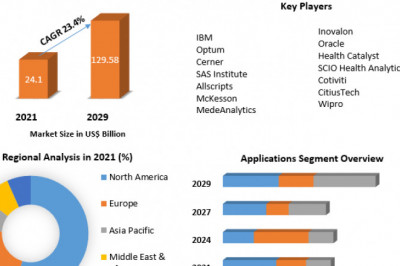views
In today's digital age, safeguarding digital assets has become more crucial than ever. With the rapid advancement of technology, cyber threats loom larger, challenging organizations to rethink their security measures. Enter AI-driven security solutions, which are not only revolutionizing the way we protect our data but also shaping the future of cybersecurity. This blog post explores how AI plays a pivotal role in defending against threats, offering insights into its benefits, applications, and what the future holds for digital asset protection.
The Growing Importance of Cybersecurity
In an increasingly interconnected world, cybersecurity is no longer just an IT issue—it's a vital component of business strategy. Every day, we see the latest cybersecurity news highlighting breaches and vulnerabilities affecting both individuals and businesses. With more sensitive data being stored online, the stakes are higher than ever. Companies now understand that robust security measures are essential to maintain trust and ensure the longevity of their business operations.
The rise of cloud computing and IoT devices has further amplified these concerns. These technologies, while convenient, open up new avenues for cyberattacks. Hackers constantly evolve, finding novel ways to bypass traditional security measures. Hence, it becomes imperative for businesses to adopt advanced security solutions that can adapt and respond to these dynamic challenges.
AI-driven security solutions stand out as a promising answer to these problems. By leveraging artificial intelligence, companies can enhance their security protocols, making them more efficient and proactive. AI offers a unique set of tools to identify and neutralize threats before they cause damage, thus becoming an indispensable part of any cybersecurity strategy.
How AI Transforms Security Protocols?
Artificial intelligence has the potential to transform how we approach cybersecurity. Unlike traditional security measures that rely on predefined rules, AI systems can learn and adapt, making them ideal for dealing with evolving threats. Machine learning algorithms can analyze vast amounts of data, identifying patterns and anomalies indicative of a potential breach.
One of the primary advantages of AI in cybersecurity is its ability to provide real-time threat detection. AI systems can monitor network traffic continuously, flagging suspicious activities as they happen. This proactive approach significantly reduces the time it takes to respond to potential threats, thereby minimizing damage.
Furthermore, AI can automate many aspects of cybersecurity, freeing up human resources for more strategic tasks. By handling mundane and repetitive tasks, AI allows security teams to focus on more complex issues, improving overall efficiency. This shift not only enhances the effectiveness of security protocols but also leads to more motivated and productive teams.
Identifying Threats with Machine Learning
Machine learning is a subset of AI that focuses on developing systems that can learn and improve from experience. In the realm of cybersecurity, machine learning algorithms play a crucial role in identifying threats. By analyzing historical data, these algorithms can predict future attacks and suggest preventive measures.
For instance, machine learning can be used to detect ransomware attacks—a growing concern in today's cybersecurity landscape. By studying past ransomware incidents, machine learning models can identify common characteristics and behaviors associated with such attacks. This knowledge allows the system to detect and block similar threats before they can cause harm.
Additionally, machine learning can help in phishing detection. Phishing remains one of the most common methods used by cybercriminals to gain unauthorized access to sensitive information. AI models can analyze emails and web pages, identifying patterns that are typically associated with phishing attempts. This proactive identification helps in preventing data breaches and maintaining the integrity of digital assets.
Enhancing User Authentication with AI
User authentication is a critical aspect of cybersecurity. Ensuring that only authorized individuals have access to sensitive information is paramount for protecting digital assets. AI can enhance traditional authentication methods, providing more robust security.
Biometric authentication is one area where AI has made significant strides. By utilizing facial recognition, fingerprint scanning, and voice recognition, AI can verify user identities with high accuracy. These methods are not only more secure but also more convenient for users, reducing the need for complex passwords.
AI can also enhance multi-factor authentication by analyzing user behavior. By monitoring how users interact with their devices, AI systems can build profiles that help in verifying identities. Any deviation from regular behavior can trigger additional security checks, ensuring that only legitimate users gain access.
By incorporating AI into authentication processes, businesses can offer a seamless yet secure experience to their users. This not only enhances security but also improves user satisfaction, as they can access their accounts effortlessly while knowing their data is safe.
Automating Incident Response with AI Tools
Responding to security incidents promptly is crucial to prevent data breaches and minimize losses. AI tools can automate many aspects of incident response, ensuring that threats are dealt with swiftly and efficiently.
AI-driven systems can quickly analyze incidents, determining the nature and extent of the threat. This rapid assessment allows security teams to prioritize their response, tackling the most severe issues first. Automation also reduces the risk of human error, ensuring that incidents are handled consistently and effectively.
Furthermore, AI can aid in forensic analysis, providing insights into how an incident occurred and what steps can be taken to prevent similar events in the future. This continuous learning loop enhances an organization's overall security posture, making them more resilient to cyber threats.
With AI automating incident response, businesses can ensure that their digital assets are protected, even in the face of sophisticated attacks. This proactive approach not only safeguards data but also builds trust with customers, as they know their information is in safe hands.
Predictive Analytics for Proactive Security
Predictive analytics is a powerful tool that can help businesses anticipate and prevent cyber threats. By analyzing historical data, AI systems can identify trends and make predictions about potential future attacks.
For example, AI can analyze network traffic patterns, identifying unusual activities that may indicate a forthcoming attack. By predicting these incidents, businesses can take preventive measures, strengthening their defenses before a breach occurs.
Predictive analytics can also aid in vulnerability management. By identifying potential weaknesses in a system, AI can suggest patches and updates to bolster security. This proactive approach ensures that businesses stay one step ahead of cybercriminals, reducing the risk of successful attacks.
By leveraging predictive analytics, organizations can not only protect their digital assets but also optimize their security strategies. This forward-thinking approach ensures that they are well-equipped to handle the dynamic and evolving landscape of cybersecurity.
Addressing Privacy Concerns with AI
While AI offers numerous benefits for cybersecurity, it also raises privacy concerns. The collection and analysis of large amounts of data can potentially infringe on individual privacy rights. Businesses must strike a balance between leveraging AI for security and protecting user privacy.
Implementing robust data protection measures is crucial. Businesses should ensure that AI systems only access data necessary for security purposes and that this data is stored securely. Regular audits and compliance checks can help in maintaining transparency and building trust with users.
Additionally, businesses should focus on developing AI systems that prioritize privacy by design. By incorporating privacy considerations from the outset, organizations can create solutions that respect user rights while providing robust security.
By addressing privacy concerns proactively, businesses can leverage the full potential of AI for cybersecurity while maintaining user trust. This balanced approach ensures that digital assets are protected without compromising personal freedoms.
AI and the Fight Against Ransomware
Ransomware attacks are a growing concern for organizations worldwide. These attacks can cripple businesses, leading to significant financial losses and reputational damage. AI offers a powerful defense against ransomware, helping businesses detect and neutralize these threats.
AI systems can analyze network traffic, identifying patterns that may indicate a ransomware attack. By detecting these threats early, businesses can take preventive measures, ensuring that their data remains secure.
Additionally, AI can aid in incident response, providing insights into how an attack occurred and what steps can be taken to mitigate damage. This rapid response helps in minimizing the impact of ransomware and ensures that businesses can recover quickly.
By leveraging AI in the fight against ransomware, organizations can protect their digital assets and avoid the devastating consequences of these attacks. This proactive approach is essential in today's cybersecurity landscape, where ransomware remains a significant threat.
Building a Cybersecurity Culture with AI
Creating a strong cybersecurity culture is essential for protecting digital assets. By fostering an environment where security is a shared responsibility, businesses can enhance their overall security posture.
AI can play a crucial role in building this culture. By providing insights and recommendations, AI systems can empower employees to take proactive steps in securing their data. Training programs and workshops can further enhance awareness, ensuring that everyone understands the importance of cybersecurity.
Additionally, AI can provide real-time feedback, helping employees identify potential threats and take corrective actions. This continuous learning loop ensures that the entire organization remains vigilant, ready to tackle any security challenges that arise.
By integrating AI into their cybersecurity culture, businesses can create an environment where security is prioritized and digital assets are protected. This proactive approach not only safeguards data but also builds trust with customers, as they know their information is in safe hands.
Collaboration Between AI and Human Experts
While AI offers numerous benefits for cybersecurity, human expertise remains crucial. AI is a powerful tool, but it requires skilled professionals to interpret its insights and make informed decisions.
Collaboration between AI systems and human experts can enhance cybersecurity efforts. AI can handle repetitive tasks and provide data-driven insights, while human experts can focus on strategic issues and decision-making.
For example, AI can identify potential threats, while security analysts assess the risks and determine the best course of action. This collaboration ensures that businesses have a comprehensive approach to cybersecurity, leveraging the strengths of both AI and human expertise.
By fostering collaboration, organizations can build a robust security framework that protects their digital assets. This partnership between AI and humans is essential for navigating the complex and dynamic landscape of cybersecurity.
The Future of AI-Driven Security Solutions
The future of cybersecurity lies in AI-driven solutions. As cyber threats continue to evolve, AI will play an increasingly important role in protecting digital assets.
Emerging technologies such as quantum computing and blockchain will further enhance AI's capabilities, providing even more robust security solutions. These advancements will enable businesses to stay ahead of cybercriminals, ensuring that their data remains secure.
However, the successful integration of AI into cybersecurity requires ongoing investment and innovation. Businesses must remain committed to exploring new technologies and adapting to changing threats.
By staying at the forefront of AI-driven security solutions, organizations can protect their digital assets and maintain a competitive edge. This forward-thinking approach ensures that they are well-equipped to handle the challenges of the future, safeguarding their data and building trust with customers.
In conclusion, AI-driven security solutions represent the future of digital asset protection. By leveraging AI's capabilities, businesses can enhance their security protocols, providing robust protection against evolving threats. This proactive approach not only safeguards data but also builds trust with customers, ensuring that their information is in safe hands. For businesses looking to explore AI-driven security solutions further, resources and expert guidance are available to help them on their journey to a more secure future.











